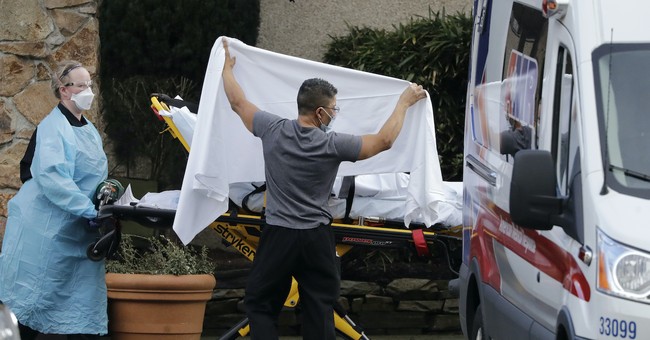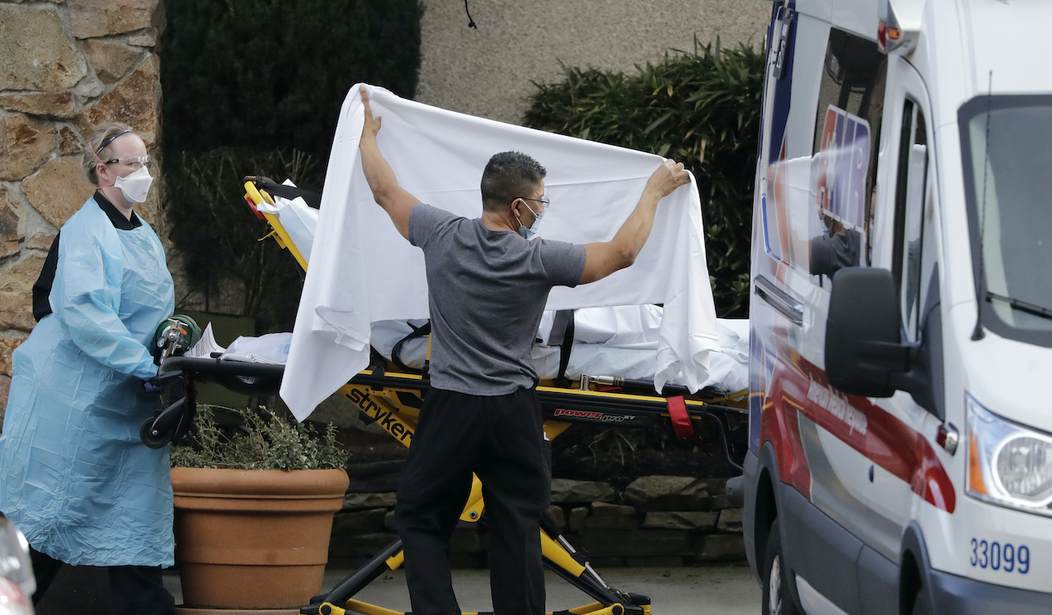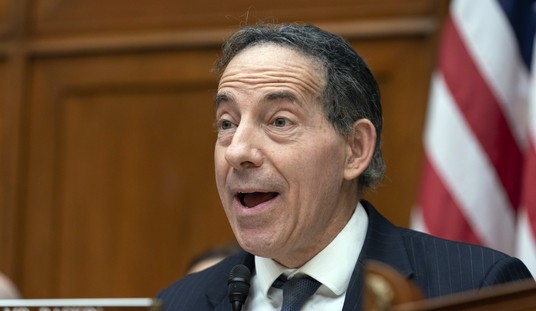
A staff member blocks the view as a person is taken by a stretcher to a waiting ambulance from a nursing facility where more than 50 people are sick and being tested for the COVID-19 virus, Saturday, Feb. 29, 2020, in Kirkland, Wash. (AP Photo/Elaine Thompson)
A little earlier today, my colleague Susie Moore posted a great story on how the criticism of seven governors who did not issue ‘shelter-in-place’ orders not only does not stand up to any sort of scrutiny, it appears that the existence of such orders have minimal effect on outcomes. READ The Criticism of Those States Who Issued No (or “Late”) Stay-at-Home Orders Doesn’t Really Hold Water.
This is a phenomenon that has been noticed by an increasing number of people. While we are assured that it is essential to bring our lives to a screeching halt in order to prevent the spread of Wuhan virus, there is actually no real evidence of the measurable kind that backs up that supposition. Zero. For instance, let’s take a look a Sweden. Unlike Britain, where the cops are kicking in doors to find out if you are hosting an unauthorized social gathering:
GRAPHIC: Police smashed a residents door in looking for 'social gatherings'. The police are out of control. These Police should be prosecuted for criminal damage and abuse of power. Got given a right serve. #CoronaPolice #CoronaCops pic.twitter.com/QbJKDWPdFT
— Critical💯 (@LogicalWeapon) April 13, 2020
Or New Zealand, where the police send helicopters to roust you out of your remote campsite because the real purpose of the whole ‘shelter-in-place’ nonsense is to remind you that you can’t do sh** without the State’s permission:
When u social distance so well that the cops have to find u by helicopter pic.twitter.com/iOmd0AOqCf
— rooftop nicoco (@PetiteNicoco) April 12, 2020
Sweden’s policy is based on the novel concept that adults have the agency to make decisions for themselves. Up until about 9/11, that was pretty much the guiding principle in the United States, but 20 years of the War on Terror and encroaching police authority have reduced us from the people of Manifest Destiny to a bunch of mewling, pathetic weaklings who can’t take a dump without the correct form from the right government department.
As many public spaces throughout Europe empty out—with citizens only leaving home for essential groceries or medication—life in Sweden is carrying on, mostly as usual. Children walk to school while adults meet up for dinner at their local bar. Only the vulnerable have been advised to isolate and some are working from home. Yet in Sweden, where there are 9,141 confirmed cases and 793 people have died, experts worry weaker measures may be leading to a more severe outbreak in the country of just 10 million citizens.
Sweden has a relatively high case fatality rate: as of April 8, 7.68% of the Swedes who have tested positive for COVID-19 have died of the virus. Neighboring countries, like Norway and Denmark, have case fatality rates of 1.46% and 3.85% respectively. (The U.S. case fatality rate is 3.21%.) While Sweden’s elevated case fatality rate could be a result of its low testing rates compared to its neighbors, experts say Sweden’s laissez-faire approach could also be to blame.
The Swedish government continues to advocate for relaxed measures. The Swedish Public Health Agency cautions citizens to cover their mouths when they cough or sneeze and wash hands regularly but does not call for lockdown measures. On March 11, the government cut down the size of permitted gatherings to 500, and only lowered that down to 50 on March 29. Other countries, like Germany and Australia, have prohibited gathering in groups larger than two. On Monday, Sweden declared that domestic flights would continue running, despite the risks domestic travel poses for spreading the disease.
Anders Tegnell, Sweden’s chief epidemiologist overseeing the government’s response to COVID-19 has said the government should allow the virus to spread slowly through the population, an approach initially employed by the United Kingdom and the Netherlands before both countries rapidly changed strategy amid mounting evidence that this approach would still overburden health care systems. Tegnell told Swedish TV on April 5 that COVID-19 could be stopped by “herd immunity or a combination of immunity and vaccination.” (A vaccine for COVID-19 is likely at least 14 months away.)
And yet, when we look at the data, the case rate of Wuhan is Sweden is 1084/million. Compare and contrast with 1552/million in Germany and 1773/million in the United States. The death rate seems to be higher than many countries…what that means, I don’t really know because it is more obvious by the day that New York is juicing its number of deaths attributed to Wuhan virus…but, if Sweden were a part of the US, it would be rated well below New York, New Jersey, Louisiana, Michigan, Connecticut, and Massachusetts in deaths. It would be less than one-fifth the death rate in New York and schools would be in sessions, businesses would be running, and restaurants would be open. Idiot governors would not be banning the sale of child passenger safety seats as ‘non-essential.’ People attending Easter services would not be being harassed by state police.
I am going to follow up with data directly from Sweden but it appears deaths are plunging – not a shock, given the ICU trends. Recall, Sweden has no lockdown. Deaths per-capita have been far lower than the U.K., Italy, France, or Spain, just higher than other Nordic countries. pic.twitter.com/D7iAVOGp9o
— Alex Berenson (@AlexBerenson) April 13, 2020
(Disclosure, I’m a fan of Berenson’s John Wells novels and it is sort of amazing to watch someone who was a reflexive and vitriolic anti-Trumper become something of a libertarian)
So, if Sweden is healthier than a lot of Europe, with no lockdown being enforced, then what are we getting for the price of the lockdown?
Over at Medium, there is an interesting post that hints at the answer to that question. It is titled Let’s Visualize State-by-State Shutdown Effectiveness on COVID-19. Here’s the teaser:
Parents want to let their kids play on park swings and others are looking for a break from sheltering at home. However, none of us want to be responsible for unnecessary deaths and we all want to do our part, so these can be difficult questions to think through and perhaps even uncomfortable to ask.
How effective are State wide shutdowns versus more measured approaches? That is what I will analyze in this post by looking at the data. As a spoiler, there is not much evidence that State wide shutdowns have a significant impact on total deaths. How can this be? Let’s walk through the numbers. You can also download my data and analysis spreadsheet here.
In fact, as the article lays out, if you examine the date of the ‘shelter-in-place’ order in relation to the first reported case of Wuhan against projected deaths (these numbers are from the rather extreme IMHE model so they really aren’t all that close to reality, the results would be more stark and shocking if you used actual day-by-day death/hospitalization data), you find there is no relationship between outcomes, as measured in deaths, and when the order was issued. Logically, if these orders accomplished much, you’d find that the sooner the order was implemented the fewer the deaths. In short, there is no evidence that the draconian infringements upon our liberties are anything more than an exercise of power by petty bureaucrats and a way of letting the rubes feel like they are doing something productive.
This is very much as Susie Moore pointed out, that is, the data from states with no extraordinary measures are no worse than that from states which are shutting down church services and hounding Christians with mandatory quarantine notices.
The Wuhan virus is a part of our ecosystem. Period. The odds of finding a successful vaccine approach zero. The feasibility of inflicting another round of shutdowns in November should also be zero. Our only hope is to follow Sweden’s example, accept that the virus is going to spread, and just deal with it.














Join the conversation as a VIP Member